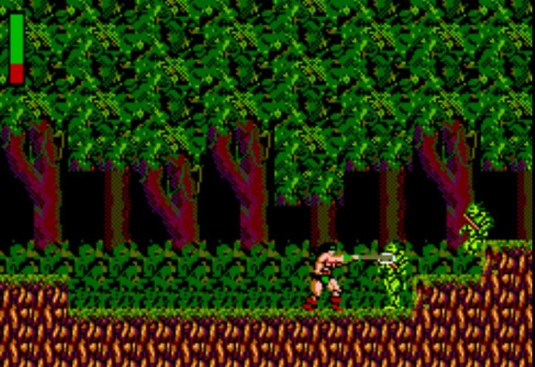
Well yes, of course it bloody does. Rastan was a Taito coin-op released in 1987. Heavily "inspired" by Conan the Barbarian, you are cast as the titular hero (or anti-hero, as it turns out) on a quest to slay a dragon and steal its fortune. Quite what our friend of Smaug has done to you in unclear, but it serves as an excuse to make your way through several overworld and underground levels of light platforming, and slicing and dicing of enemy lizard men, chimeras, harpies, and other undesirables and imponderables. Along the way time-limited power ups are available that lessen damage taken from enemies, as well as some nice weapons too. Your sword can be traded up for a mace, a battleaxe, a fireball-shooting chopper, and various potions are dotted about to restore bits of your health or, gasp, take it away. In addition to baddies there are pits to leap over, lava and water to dodge, and traps to avoid. And can you tell what lies at the end of every level? Why, a scrap with a boss of some description.
The Master System version for its part does a good job of mimicking the arcade. Its layout differs from the coin-op, presumably to press the value-for-money button, but the core gameplay is exactly the same. Graphically its fine and puts its 8-bit competition on the home micros to shame. Sound-wise, the Master System wasn't blessed with the beefiest of chips but Taito's programmers did an excellent job of turning out atmospheric tunes, which was no mean feat. But the specificity of games lie in their gaminess. Does Rastan play well? Here's where what passed muster in yesteryear wouldn't necessarily do so today. That's one way of saying there are some issues.
Issue number one is the stiffness of it all. Making a jump, which is a necessary part of the game, is like working against the grain of some invisible substance. As such, accurate leaping is unnecessarily tricky. This can become a real bind when you get stuck in a small lava/water pit between pillars of rock. You see, wee Rastan is blessed with two sorts of jumps - one a short hop which is pretty useless, and a biggie activated by pressing the jump button and the D-pad up. Here, when you try leaping out of your doom you tend to sail straight over the platform to land down another pit. Not great. Also the momentum to jumping is very limited - it's like you get to a certain point in your leaping arc ... and then you plummet like a stone. Thankfully, being a muscle-bound hard arse there's no damage from big drops - unlike some video game characters.
The second is a bane of many an 8-bit game: collision detection. Offing your foes requires they be at the right length from you to fall (or rather explode) at the bite of your blade. Too close and, well, you can't kill 'em. This is particularly annoying later on in the game when you attract the ministrations of giant hornets. It can literally be hovering above Rastan's bonce and you can be thrusting your sword up at it as you please, but our insectile nemesis refuses to die. This gets ridiculous when you get to the boss fights. The enemies have fairly simple and straightforward attack patterns, but just try developing a pattern of your own to get them gone. Half the time it's a matter of luck whether your sword hits them. This is with the exception of the final boss who is fairly easy to dispatch once the routine is learned and deployed. If only all the others were the same.
Rastan today is fairly well-remembered, but its home conversions aren't what you'd describe as canonical games. In Master System land there are plenty of slash 'em ups with platform elements, and Rastan is one of the better ones. Nevertheless, its ending does have a nice touch. With the dragon dead and its minions dispersed to the four winds, the local king is effusive with praise and offers you his realm if you take his daughter's hand - who just so happens to love you. Snore. Riffing off Conan again, Rastan declares himself nothing but a thief and slips into the night for further questing. As he didn't take the treasure, it makes you wonder how seriously he takes his thieving, as well as what the point of the game was. Likewise, what's the point of sinking time into this 1988 release some 30-odd years later? From a curiosity point of view, it does demonstrate the Master System could handle decent conversions in the hands of competent programmers, and it holds up very well against competing but similar titles on Nintendo's machine, But culturally, it is a desert. Absent are innovations that have left a trace in the game mechanics meta, apart from - for a while - being the only decent hack 'n' slash platforming experience in the arcades. Very soon after the release, shooting things became the standard for action platformers and swords migrated over to beat 'em ups - above all Sega's Golden Axe, with its own Rastan/Conan inspired player character. And later to one-on-one fighters.
All this said, Rastan wasn't bad for the standards of its day. Gamers unused to old stuff would find it hard going, but for the wrinklies it will reactivate the gaming habitus of old and perhaps see their like treat it with a little more patience. If you have something for retro curios, you'll do much better with the Master System than any other home version of the game.
Image Credit
No comments:
Post a Comment